Avalon

Avalon (real name Diana) is about the only known royalty fan from Armenia, with a tendency to bore her friends to death with history and royalty lectures. She is also a passionate Harry Potter, Alan Rickman, football, horse-riding, chocolate, ice-cream and UK fan.
Introduction
In the last couple of centuries, English princes and kings mainly married princesses from German royal houses, and we often forget that France holds the record for most English queen consorts. Indeed, all the English kings from Henry II to Henry VI, with the exception of Richard I, Edward III [1] and Henry IV, were married to French princesses. The main reason for the unions of princes and princess from English and French royal houses was the hope that they would establish peace between the two countries. Some of these princesses left quite visible traces in history, some were truly extraordinary women, and some are notable through their descendants. All of them were different and had different fates – from neglected wives who eventually retaliated, to beloved wives, to those who had to overcome personal tragedies. My only regret is the lack of opportunity to talk about any of Henry VIII’s wives: I can’t understand how he managed not to marry a French princess, given that he was married six times. But that's a topic for another article (or book), so I'll restrict myself solely to French princesses. So, let’s have a look at the Jewels who were once parts of the English Crown.
The Pearl of France
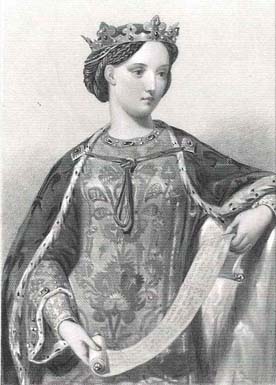 My favourite has always been the relatively unknown Marguerite of France. Being married to Edward I would be enough to earn a bonus point from me because it couldn't have been an easy experience, but personally I would consider that one of her biggest achievements was avoiding "second-wife" syndrome - when your stepchildren regard you as an evil stepmother and people hate you simply because you came after the beloved first wife (poor Anne Boleyn pops into my mind): she was on friendly terms with all her stepchildren, who called her "sister," and was one of those rare foreign princesses whom the English people did not just like but adored. But perhaps most amazingly, she was genuinely happy with a man who was 46 years older, and not just any man but Edward I, who was not exactly famous for his good nature. The young French princess lived for her family and her people: when she was not busy trying to mend relationships between King Edward and his heir, Prince Edward (Edward I’s greatest regret of his whole life was leaving the weak Prince Edward as his successor – and as history would show, he was right), she was trying to make the life of the common people more bearable. It is known that she persuaded the King not to increase taxes on at least one occasion, for the peasants were already starving. After Edward I’s death, Marguerite refused to remarry, saying "all men died for me, when Edward died." She was only 26 at the time. Her stepchildren always treated her with the utmost love and respect, and their grief at her funeral, as well as the grief of thousands of ordinary people who lined the streets, was genuine – many didn’t even try to hide their tears as they said their final goodbye to the "Pearl of France."
My favourite has always been the relatively unknown Marguerite of France. Being married to Edward I would be enough to earn a bonus point from me because it couldn't have been an easy experience, but personally I would consider that one of her biggest achievements was avoiding "second-wife" syndrome - when your stepchildren regard you as an evil stepmother and people hate you simply because you came after the beloved first wife (poor Anne Boleyn pops into my mind): she was on friendly terms with all her stepchildren, who called her "sister," and was one of those rare foreign princesses whom the English people did not just like but adored. But perhaps most amazingly, she was genuinely happy with a man who was 46 years older, and not just any man but Edward I, who was not exactly famous for his good nature. The young French princess lived for her family and her people: when she was not busy trying to mend relationships between King Edward and his heir, Prince Edward (Edward I’s greatest regret of his whole life was leaving the weak Prince Edward as his successor – and as history would show, he was right), she was trying to make the life of the common people more bearable. It is known that she persuaded the King not to increase taxes on at least one occasion, for the peasants were already starving. After Edward I’s death, Marguerite refused to remarry, saying "all men died for me, when Edward died." She was only 26 at the time. Her stepchildren always treated her with the utmost love and respect, and their grief at her funeral, as well as the grief of thousands of ordinary people who lined the streets, was genuine – many didn’t even try to hide their tears as they said their final goodbye to the "Pearl of France."
Her achievements are all the more impressive, given that she was never supposed to become Queen of England in the first place: after the death of his beloved first wife, Eleanor of Castile, Edward I sought the hand of Blanche of France, Marguerite’s older sister. Since Blanche was already engaged, their brother, Philip IV, basically tricked Edward into marrying Marguerite. Edward didn’t have to regret this twist of fate though: words he once said about Marguerite - “I’ve gained a pearl of a great price, which has no rivals and no matches” - were the inspiration for the title of this article.
The Duchess of Aquitaine, the She-Wolf of France, and the Catholic Queen
One can hardly overestimate the impact of Eleanor of Aquitaine, Isabella of France, and Henrietta Maria of France on English history. None of them were ever popular, though none did awful things, and certainly none was worse than most of the English-born or German princesses. Of the three, only Eleanor of Aquitaine was at all popular, mainly because people saw her as a trophy which their King Henry II had won from the French king.
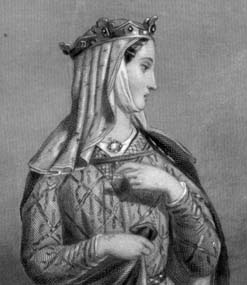 We all know plenty about Eleanor of Aquitaine, the heiress of the largest, richest, and most cultured province in France, and yet we are sadly ignorant of the great legacy Eleanor left, and I don’t mean her presumed theatrical murder of Fair Rosamund – the words "Choose your death, it will be either knife or poison" were attributed to her only in the 17th century, and in any case it is almost certain that Rosamund was not murdered at all. I am talking about the legacy Eleanor left as a woman, what she did for the rights and perception of the women of her times, and her legacy as Queen of England. While married to her first husband, Louis VII of France, Eleanor took part in the Holy Crusade, something very few women would dare to do, not only because of the dangers but also because women were supposed to wait for their husbands at home with a delicious meal and a smile worthy of a beauty contestant. It is said that Louis almost had a heart attack or at least a seizure when he heard of this but he didn’t have the guts to get her to change her mind. Throughout her life, Eleanor stressed the importance of education for all people and was patron of many notable artists of her time. Although she described her life with her second husband, Henry II, as "happier than I ever had with Louis," her problems included Henry’s numerous mistresses and illegitimate children (although she cared for some of the children), several rebellions against him, 16 years of imprisonment, and, worst of all, considerable hair loss close to her 60s. But Eleanor wouldn't have been herself if she hadn't managed to overcome everything. While serving as Regent for her son Richard, who was too interested in murdering non-Christians during the Crusades to care for something as insignificant as ruling a country, this exceptional women proved to be a much more capable ruler than most of her male contemporaries. Eleanor was queen for 65 years and died at the ripe old age of 82. Although she was not too well loved in France (her vast lands, merged with other lands the English Crown already possessed in France, resulted in the rather awkward situation where the English King had more French lands than the French King himself), at the time of her death Eleanor was easily Europe’s most powerful and respected woman. Troubadours still dedicated songs to her and praised her beauty, although the latter was perhaps common courtesy, given her age. Eleanor of Aquitaine is a popular figure in fiction; most famously, Eleanor and Henry are the main characters in the movie The Lion in Winter, where they are portrayed by the magnificent Katharine Hepburn and Peter O’Toole.
We all know plenty about Eleanor of Aquitaine, the heiress of the largest, richest, and most cultured province in France, and yet we are sadly ignorant of the great legacy Eleanor left, and I don’t mean her presumed theatrical murder of Fair Rosamund – the words "Choose your death, it will be either knife or poison" were attributed to her only in the 17th century, and in any case it is almost certain that Rosamund was not murdered at all. I am talking about the legacy Eleanor left as a woman, what she did for the rights and perception of the women of her times, and her legacy as Queen of England. While married to her first husband, Louis VII of France, Eleanor took part in the Holy Crusade, something very few women would dare to do, not only because of the dangers but also because women were supposed to wait for their husbands at home with a delicious meal and a smile worthy of a beauty contestant. It is said that Louis almost had a heart attack or at least a seizure when he heard of this but he didn’t have the guts to get her to change her mind. Throughout her life, Eleanor stressed the importance of education for all people and was patron of many notable artists of her time. Although she described her life with her second husband, Henry II, as "happier than I ever had with Louis," her problems included Henry’s numerous mistresses and illegitimate children (although she cared for some of the children), several rebellions against him, 16 years of imprisonment, and, worst of all, considerable hair loss close to her 60s. But Eleanor wouldn't have been herself if she hadn't managed to overcome everything. While serving as Regent for her son Richard, who was too interested in murdering non-Christians during the Crusades to care for something as insignificant as ruling a country, this exceptional women proved to be a much more capable ruler than most of her male contemporaries. Eleanor was queen for 65 years and died at the ripe old age of 82. Although she was not too well loved in France (her vast lands, merged with other lands the English Crown already possessed in France, resulted in the rather awkward situation where the English King had more French lands than the French King himself), at the time of her death Eleanor was easily Europe’s most powerful and respected woman. Troubadours still dedicated songs to her and praised her beauty, although the latter was perhaps common courtesy, given her age. Eleanor of Aquitaine is a popular figure in fiction; most famously, Eleanor and Henry are the main characters in the movie The Lion in Winter, where they are portrayed by the magnificent Katharine Hepburn and Peter O’Toole.
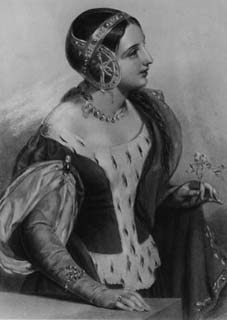 Isabella, the she-wolf of France (that nickname comes from Shakespeare’s play Henry VI, where it refers to Margaret of Anjou), was the young and beautiful wife of Edward II, a man who nevertheless preferred not so young and handsome male favourites. But the proud daughter of Philip the Fair was not going to put up with this: when her brother seized Edward’s lands in France, she pretended to be the loyal wife and agreed to go and persuade her "treacherous" brother to return the lands. Once in France, she immediately started plotting against Edward - not too difficult a task, considering his unpopularity. The Earl of Arundel allegedly said, "I shall endure that French women behind the throne, but not Edward on the throne." With the support of the barons and her lover Roger Mortimer (did I forget to mention that Isabella was no saint either?), she landed on English soil and, without one battle, deposed Edward and proclaimed their son, Edward III, as king. Isabella almost achieved what many English kings had tried to do: to unite the kingdoms of England and France. Her son was the only male grandson of Philip IV and could claim the French crown based on the Old Salic Law (which banned women from inheriting the throne but allowed their male descendants to claim it). However, Philip V changed the law in France precisely to avoid that. Although Isabella continued her affair with Mortimer for many years (until Edward III executed him), ironically she seemed to still love her husband: on her deathbed Isabella stipulated that she should be buried in her wedding dress, with Edward’s heart buried with her. Isabella is a popular figure in fiction. Most notably, she is a prominent figure in the historical-fiction movie Braveheart, where this famous beauty is played by another beauty, Sophie Marceau. The film is far from accurate, though: according to the movie, Isabella had an affair with Scottish hero William Wallace, who is hinted to be the real father of her son, the future Edward III. A beautiful story, but when Wallace was executed Isabella was only 10 years old. Mel Gibson might have felt that a great king like Edward III couldn’t have been fathered by the worthless Edward II. But he forgot that Edward III had a remarkable mother.
Isabella, the she-wolf of France (that nickname comes from Shakespeare’s play Henry VI, where it refers to Margaret of Anjou), was the young and beautiful wife of Edward II, a man who nevertheless preferred not so young and handsome male favourites. But the proud daughter of Philip the Fair was not going to put up with this: when her brother seized Edward’s lands in France, she pretended to be the loyal wife and agreed to go and persuade her "treacherous" brother to return the lands. Once in France, she immediately started plotting against Edward - not too difficult a task, considering his unpopularity. The Earl of Arundel allegedly said, "I shall endure that French women behind the throne, but not Edward on the throne." With the support of the barons and her lover Roger Mortimer (did I forget to mention that Isabella was no saint either?), she landed on English soil and, without one battle, deposed Edward and proclaimed their son, Edward III, as king. Isabella almost achieved what many English kings had tried to do: to unite the kingdoms of England and France. Her son was the only male grandson of Philip IV and could claim the French crown based on the Old Salic Law (which banned women from inheriting the throne but allowed their male descendants to claim it). However, Philip V changed the law in France precisely to avoid that. Although Isabella continued her affair with Mortimer for many years (until Edward III executed him), ironically she seemed to still love her husband: on her deathbed Isabella stipulated that she should be buried in her wedding dress, with Edward’s heart buried with her. Isabella is a popular figure in fiction. Most notably, she is a prominent figure in the historical-fiction movie Braveheart, where this famous beauty is played by another beauty, Sophie Marceau. The film is far from accurate, though: according to the movie, Isabella had an affair with Scottish hero William Wallace, who is hinted to be the real father of her son, the future Edward III. A beautiful story, but when Wallace was executed Isabella was only 10 years old. Mel Gibson might have felt that a great king like Edward III couldn’t have been fathered by the worthless Edward II. But he forgot that Edward III had a remarkable mother.
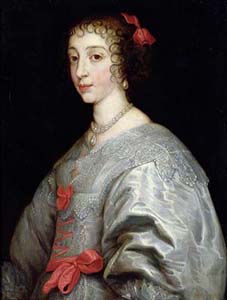 Of these three women, Henrietta Maria of France arguably had the greatest impact on history. She was an intelligent woman but didn’t differ much from other princesses of her time: the only major difference was that she was a Catholic queen in Protestant England. King Charles I was leaning towards Catholicism, and Henrietta was seen as a bad influence on him. She was also quite active on the political scene, another point against her in England, where the consort was expected to support but never interfere. Good mother and wife as she was, Henrietta Maria failed to see and meet the needs of her adopted country. When the Civil War broke out, she actively sought money to fund her husband’s military campaign, but unfortunately she concentrated mainly on Catholic sources, with Pope Urban VIII among the most prominent. This not only angered English noblemen and ordinary people but also greatly hindered Charles’ efforts. Although she failed to be a good queen for England, she was a very devoted wife, and her husband’s execution broke her heart. It was a difficult time for Henrietta Maria, especially since she was left destitute as well. She tried to find peace and comfort in religion, but greatly angered Royalists, common people, and her eldest son alike by trying to convert her youngest son, Henry, to Catholicism. Henrietta Maria's influence was one of the reasons for the Civil War, which saw her husband executed and the monarchy abolished, even if only for a short time. Her influence over the king was also one of the reasons for the provision in the Act of Settlement of 1701 prohibiting all those in the line of succession to the British throne from marrying Catholics. Nowadays, Henrietta Maria is best remembered from Alexander Dumas’ Twenty Years Later, where both she and Charles are portrayed in a rather idealized way. The U.S. state of Maryland (Terra Mariae in Latin) was named after her, as was the ill-fated slave ship Henrietta Maria, which sank, taking the lives of almost 200 slaves.
Of these three women, Henrietta Maria of France arguably had the greatest impact on history. She was an intelligent woman but didn’t differ much from other princesses of her time: the only major difference was that she was a Catholic queen in Protestant England. King Charles I was leaning towards Catholicism, and Henrietta was seen as a bad influence on him. She was also quite active on the political scene, another point against her in England, where the consort was expected to support but never interfere. Good mother and wife as she was, Henrietta Maria failed to see and meet the needs of her adopted country. When the Civil War broke out, she actively sought money to fund her husband’s military campaign, but unfortunately she concentrated mainly on Catholic sources, with Pope Urban VIII among the most prominent. This not only angered English noblemen and ordinary people but also greatly hindered Charles’ efforts. Although she failed to be a good queen for England, she was a very devoted wife, and her husband’s execution broke her heart. It was a difficult time for Henrietta Maria, especially since she was left destitute as well. She tried to find peace and comfort in religion, but greatly angered Royalists, common people, and her eldest son alike by trying to convert her youngest son, Henry, to Catholicism. Henrietta Maria's influence was one of the reasons for the Civil War, which saw her husband executed and the monarchy abolished, even if only for a short time. Her influence over the king was also one of the reasons for the provision in the Act of Settlement of 1701 prohibiting all those in the line of succession to the British throne from marrying Catholics. Nowadays, Henrietta Maria is best remembered from Alexander Dumas’ Twenty Years Later, where both she and Charles are portrayed in a rather idealized way. The U.S. state of Maryland (Terra Mariae in Latin) was named after her, as was the ill-fated slave ship Henrietta Maria, which sank, taking the lives of almost 200 slaves.
The Rose of Troyes and The Red Rose
Catherine de Valois and Margaret of Anjou were linked in more then one way: they were second cousins; Catherine was Margaret’s mother-in-law; in her war for the crown, Margaret’s main ally was Jasper Tudor, Catherine’s son with Owen Tudor. But their major difference is more striking: Margaret was a strong woman who was married to a weak man, while Catherine was an ordinary woman, albeit very beautiful, who was married to a powerful king.
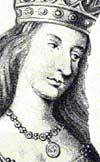 Catherine de Valois was nicknamed the Rose of Troyes because Henry V of England won her hand, as well as Aquitaine, Normandy, and the right to succeed her father, Charles VI, as King of France, in the Treaty of Troyes in 1420. Henry V was a decisive king; by the time he died, he had managed what many of his ancestors had failed to achieve: unification of the crowns of England and France. Key to that unification was his marriage to Catherine. Her father suffered from what is now believed to be schizophrenia. Taking advantage of this, Henry V invaded the greater part of France; the last hope for the French was lost with their defeat at the battle of Agincourt, which was immortalized in Shakespeare’s play Henry V. Having no choice but to agree to Henry’s conditions, Charles declared his own son a bastard, named Henry his successor, and, to seal the agreement, arranged Henry’s marriage to Catherine. Catherine was Queen of England for only one year, though: Henry died soon after their only son was born, leaving Catherine a 19-year-old widow and mother of the infant King Henry VI. Catherine was not allowed to participate in her son’s education because, being French, she was largely mistrusted. She found comfort in the arms of Owen Tudor, a Welsh clerk. This worried the Court, and Catherine was officially forbidden to remarry. Scholars argue to this day about whether Catherine and Owen were secretly married or just lived together. Her sons with Owen were to play an important role in the history of England: Edmund married Margaret Beaufort, a descendant of Edward III, and their son was the future Henry VII, founder of the Tudor dynasty; Jasper married Katherine Woodville, sister of Elizabeth Woodville (consort of Edward IV), and was a prominent figure in the history of his time. Jasper was always loyal to his half-brother, Henry VI, and it was mainly due to his brilliant strategic plans that Margaret of Anjou managed to fight for the throne for so long. Jasper took care of his nephew, the future Henry VII, and fought fiercely on his behalf against Richard III. It can thus be argued that Catherine’s greatest legacy was not even the almost achieved unification of the crowns of France and England, but her descendants. Through Edmund, she was ancestress of the current royal family; through Jasper, she was an ancestor of Oliver Cromwell.
Catherine de Valois was nicknamed the Rose of Troyes because Henry V of England won her hand, as well as Aquitaine, Normandy, and the right to succeed her father, Charles VI, as King of France, in the Treaty of Troyes in 1420. Henry V was a decisive king; by the time he died, he had managed what many of his ancestors had failed to achieve: unification of the crowns of England and France. Key to that unification was his marriage to Catherine. Her father suffered from what is now believed to be schizophrenia. Taking advantage of this, Henry V invaded the greater part of France; the last hope for the French was lost with their defeat at the battle of Agincourt, which was immortalized in Shakespeare’s play Henry V. Having no choice but to agree to Henry’s conditions, Charles declared his own son a bastard, named Henry his successor, and, to seal the agreement, arranged Henry’s marriage to Catherine. Catherine was Queen of England for only one year, though: Henry died soon after their only son was born, leaving Catherine a 19-year-old widow and mother of the infant King Henry VI. Catherine was not allowed to participate in her son’s education because, being French, she was largely mistrusted. She found comfort in the arms of Owen Tudor, a Welsh clerk. This worried the Court, and Catherine was officially forbidden to remarry. Scholars argue to this day about whether Catherine and Owen were secretly married or just lived together. Her sons with Owen were to play an important role in the history of England: Edmund married Margaret Beaufort, a descendant of Edward III, and their son was the future Henry VII, founder of the Tudor dynasty; Jasper married Katherine Woodville, sister of Elizabeth Woodville (consort of Edward IV), and was a prominent figure in the history of his time. Jasper was always loyal to his half-brother, Henry VI, and it was mainly due to his brilliant strategic plans that Margaret of Anjou managed to fight for the throne for so long. Jasper took care of his nephew, the future Henry VII, and fought fiercely on his behalf against Richard III. It can thus be argued that Catherine’s greatest legacy was not even the almost achieved unification of the crowns of France and England, but her descendants. Through Edmund, she was ancestress of the current royal family; through Jasper, she was an ancestor of Oliver Cromwell.
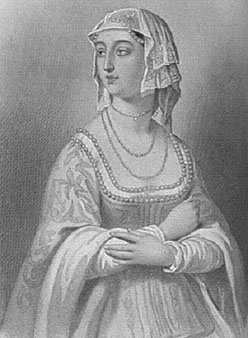 Margaret of Anjou fought a man’s war, trying to win back the throne that was rightly her son’s. The young and carefree daughter of René, King of Naples and Duke of Anjou, and Isabella, Duchess of Lorraine, married King Henry VI of England in order to establish peace between the countries. Great things were expected of the king, whose father was the famous Henry V. Henry VI became king at the age of nine months, and ever since then he had been a pawn in the hands of his powerful uncles. His mother, Catherine de Valois, was never allowed to take part in her son’s upbringing. Henry grew to be a very spiritual man who would have done a great job as a monk, but he was a poor king. He believed in the divine right of the king and tolerated no objections. Henry lost the greater part of the lands his father had conquered during the Hundred Years’ War. When Henry lost Aquitaine, the duchy that had belonged to England since the reign of Henry II, the opposition to him became widespread. That’s when 21-year-old Margaret stepped in: she personally named commanders for the English Army, took decisions, and showed leadership where her husband lacked it. In short, Margaret proved a much more competent ruler than Henry ever was. Several successful battles followed, and England regained Aquitaine and Bordeaux. During the same time, Margaret announced her pregnancy. But fate turned its back on the royal couple: England’s success was short-lived, and at the time their only son Edward was born in 1453, all the French lands but Calais were lost again. The ambitious Richard, Duke of York, took advantage of the unpopularity and mental breakdown of the king to stake his own claim to power. He wanted the throne for himself but had little support among the nobility, so the best he could do was to make Parliament, and subsequently Henry, agree to the Act of Accord in 1460, which allowed Henry to remain king for his lifetime but signed away Prince Edward's birthright and named Richard and his heirs as the king's successors.
Margaret of Anjou fought a man’s war, trying to win back the throne that was rightly her son’s. The young and carefree daughter of René, King of Naples and Duke of Anjou, and Isabella, Duchess of Lorraine, married King Henry VI of England in order to establish peace between the countries. Great things were expected of the king, whose father was the famous Henry V. Henry VI became king at the age of nine months, and ever since then he had been a pawn in the hands of his powerful uncles. His mother, Catherine de Valois, was never allowed to take part in her son’s upbringing. Henry grew to be a very spiritual man who would have done a great job as a monk, but he was a poor king. He believed in the divine right of the king and tolerated no objections. Henry lost the greater part of the lands his father had conquered during the Hundred Years’ War. When Henry lost Aquitaine, the duchy that had belonged to England since the reign of Henry II, the opposition to him became widespread. That’s when 21-year-old Margaret stepped in: she personally named commanders for the English Army, took decisions, and showed leadership where her husband lacked it. In short, Margaret proved a much more competent ruler than Henry ever was. Several successful battles followed, and England regained Aquitaine and Bordeaux. During the same time, Margaret announced her pregnancy. But fate turned its back on the royal couple: England’s success was short-lived, and at the time their only son Edward was born in 1453, all the French lands but Calais were lost again. The ambitious Richard, Duke of York, took advantage of the unpopularity and mental breakdown of the king to stake his own claim to power. He wanted the throne for himself but had little support among the nobility, so the best he could do was to make Parliament, and subsequently Henry, agree to the Act of Accord in 1460, which allowed Henry to remain king for his lifetime but signed away Prince Edward's birthright and named Richard and his heirs as the king's successors.
Margaret had been reluctant to take any action against the Duke of York, but once her son’s inheritance was in danger she immediately raised an army and led the Lancastrian contingent in the battles of the War of Roses (the red rose was on the Lancastrian badge, while the white one was the symbol of the Yorks). After a couple of Yorkist victories, the Duke of York's son Edward Earl of March was proclaimed King Edward IV in 1461. Margaret tried to gain support for the Lancastrian cause in Scotland and Wales. Her main allies were Jasper Tudor and later Richard Neville, Earl of Warwick, once her main rival. Margaret did succeed in putting Henry VI back on the throne, but just before she, her son, and her daughter-in-law (Warwick’s daughter Anne Neville, who would later marry Richard III) were triumphantly returning from exile in France, Warwick was killed at the Battle of Barnet and Edward IV was back on the throne. Margaret had little hope for success any more, and all she could do was to gather the remains of her forces at the Battle of Tewkesbury. Margaret was inexperienced, Prince Edward was very young, and they had no other notable leaders; it was not difficult for Edward IV to overcome their army, and Prince Edward was killed during the battle. He is the only Prince of Wales to ever be killed in battle. Margaret had a chance to escape, but her son’s death broke her down. She was imprisoned in the Tower of London, until 5 years later the King of France ransomed her. For a woman who had lost her husband, her son, her crown and the beauty she was once famed for, there wasn’t much to live for. Margaret, who was once famous for her will, aggression, decisive character, and beauty, was a broken spirit, who spent the remainder of her life in prayers and for whom death was a blessing.
The Child Queens
Both Isabella of Angoulême and Isabella de Valois were still children when they married John and Richard II of England, respectively. Although Isabella of Angoulême, the only daughter and heir of the Count of Angoulême, was only 13, her beauty was renowned and she was sometimes called the "Helen" of her times. Despite her young age, Isabella was also known for her passionate and forceful character. She was betrothed to Hugh X of Lusignan, but shortly before the marriage, King John, motivated by his hopes of annexing Angoulême to English lands and by rumours of Isabella’s stunning beauty, kidnapped and married her. As punishment for John’s actions, Philip II of France confiscated all of his lands in France and started an armed conflict, while the entire Lusignan family rebelled against the English king; however, neither their desperate pleas to the Pope nor their bravery on the military field had any results. Isabella and John’s marriage couldn’t be called a successful one; Isabella was 20 years younger than her husband and apparently still loved her former fiancé, Hugh. Nevertheless, they had five children: a future King of England, King of the Romans, Queen of Scotland, Empress of the Holy Roman Empire, and Countess of Pembroke. Legend says that as soon as Hugh X of Lusignan learnt of John’s death, he sent envoys to Isabella, assuring her that his feelings had not changed in any way (which is probably true, since he had never married). Apparently Isabella’s feelings hadn’t changed either, because soon after returning to France, she married Hugh and they ended up having nine children. Marrying and bearing children was not Isabella’s only occupation; although a French princess by birth, Isabella fought for the interests of her once adopted country, England, and for the interests of her son, Henry III. Close to the end of her life, the 50-year-old Isabella was accused of plotting against the French king and had to flee to Fontrevault Abbey, where she died two years later. Her children with Hugh X of Lusignan lived mostly in the kingdom of their half-brother Henry.
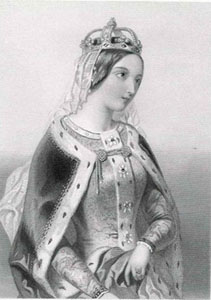 The marriage of six-year-old Isabella de Valois and 29-year-old Richard II was purely a political match and was arranged to ensure peace between England and France. Richard treated his young wife with the utmost respect, and they grew to feel mutual respect and admiration. Isabella came to regard Richard as a mixture of father and brother, and she was always loyal to his interests. The little Queen didn’t have to suffer the difficulties and misfortunes of the war: during Richard’s campaign to Ireland, Isabella enjoyed a quiet life in Wallingford Castle, where she was allowed to have a court of her own. Richard was generous toward Isabella, and she had a vast collection of the two things that interested her most: dolls and jewels. This fairytale life came to an abrupt end when Richard was deposed and imprisoned and subsequently died (or was killed) in prison. Henry IV, the new king, had no idea what to do with Isabella. She was obviously no danger to him or his heirs; on the other hand, she was young and beautiful and could secure him an alliance with France. He thus decided that Isabella should marry his son, the future Henry V of England. But Isabella put her foot down and flat refused to marry the prince. Instead, she went into mourning, ignoring Henry IV’s demands, protests, and pleas. Isabella despised Henry for presumably killing Richard, for whom she still had deep affection and respect, and in the end Henry gave up and let her go back to France. The future Henry V did marry a French princess, though - Isabella’s younger sister Catherine. The dowager Queen of England was now a grown-up lady; she was almost 17. Following her return to France, Isabella’s father arranged her marriage to Charles, Duc d’Orleans. They were a well-matched couple, but the petite Queen of France wasn’t destined to enjoy life for long: she died in childbirth at the age of 20, leaving one daughter, Jeanne, whose husband (John II of Alençon) was Joan of Arc's most prominent supporter and friend.
The marriage of six-year-old Isabella de Valois and 29-year-old Richard II was purely a political match and was arranged to ensure peace between England and France. Richard treated his young wife with the utmost respect, and they grew to feel mutual respect and admiration. Isabella came to regard Richard as a mixture of father and brother, and she was always loyal to his interests. The little Queen didn’t have to suffer the difficulties and misfortunes of the war: during Richard’s campaign to Ireland, Isabella enjoyed a quiet life in Wallingford Castle, where she was allowed to have a court of her own. Richard was generous toward Isabella, and she had a vast collection of the two things that interested her most: dolls and jewels. This fairytale life came to an abrupt end when Richard was deposed and imprisoned and subsequently died (or was killed) in prison. Henry IV, the new king, had no idea what to do with Isabella. She was obviously no danger to him or his heirs; on the other hand, she was young and beautiful and could secure him an alliance with France. He thus decided that Isabella should marry his son, the future Henry V of England. But Isabella put her foot down and flat refused to marry the prince. Instead, she went into mourning, ignoring Henry IV’s demands, protests, and pleas. Isabella despised Henry for presumably killing Richard, for whom she still had deep affection and respect, and in the end Henry gave up and let her go back to France. The future Henry V did marry a French princess, though - Isabella’s younger sister Catherine. The dowager Queen of England was now a grown-up lady; she was almost 17. Following her return to France, Isabella’s father arranged her marriage to Charles, Duc d’Orleans. They were a well-matched couple, but the petite Queen of France wasn’t destined to enjoy life for long: she died in childbirth at the age of 20, leaving one daughter, Jeanne, whose husband (John II of Alençon) was Joan of Arc's most prominent supporter and friend.
The lives of these French princesses seem very captivating for me. Their marriages were arranged in the frail hope of establishing the never-existing peace between two countries. Different as they were, one thing united all these women: they never gave up. Whether for good and noble reasons or for poor reasons, for profit or for causes they believed in, they fought till the end.
[1] Edward III was married to Philippa of Hainault, daughter of the Duke of Hainault and Jeanne of Valois (and thus a great-granddaughter of Philip II of France). Although now the territory of the Dukedom of Hainault is in France, at the time of their marriage it was in Flanders. For the same reason, Eleanor of Provence, Berengaria of Navarre, and Joanna of Navarre have been omitted from this article.
